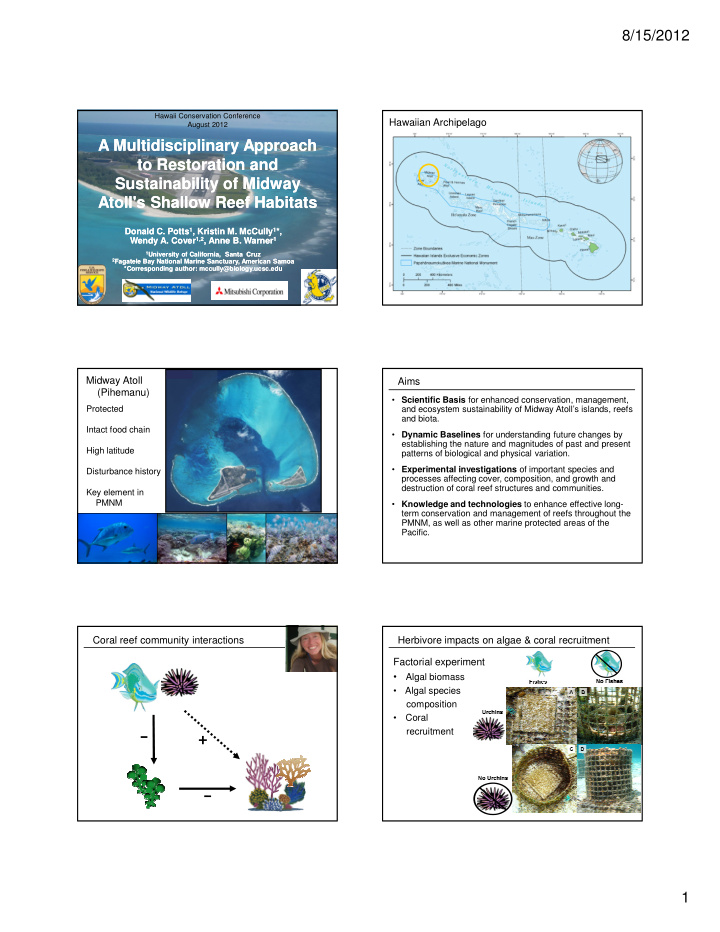



8/15/2012 Hawaii Conservation Conference Hawaiian Archipelago August 2012 A Multidisciplinary Approach A Multidisciplinary Approach to Restoration and to Restoration and Sustainability of Midway Sustainability of Midway Atoll's Shallow Reef Habitats Atoll's Shallow Reef Habitats Donald C. Potts 1 , Kristin M. McCully Donald C. Potts , Kristin M. McCully 1 *, *, Wendy A. Cover Wendy A. Cover 1,2 1,2 , Anne B. Warner , Anne B. Warner 1 1 University of California, Santa Cruz University of California, Santa Cruz 2 Fagatele Bay National Marine Sanctuary, American Samoa Fagatele Bay National Marine Sanctuary, American Samoa *Corresponding author: mccully@biology.ucsc.edu *Corresponding author: mccully@biology.ucsc.edu Midway Atoll Aims (Pihemanu) • Scientific Basis for enhanced conservation, management, Protected and ecosystem sustainability of Midway Atoll’s islands, reefs and biota. Intact food chain • Dynamic Baselines for understanding future changes by establishing the nature and magnitudes of past and present High latitude patterns of biological and physical variation. • Experimental investigations of important species and Disturbance history processes affecting cover, composition, and growth and destruction of coral reef structures and communities. Key element in PMNM • Knowledge and technologies to enhance effective long- term conservation and management of reefs throughout the PMNM, as well as other marine protected areas of the Pacific. Coral reef community interactions Herbivore impacts on algae & coral recruitment Factorial experiment • Algal biomass • Algal species composition • Coral recruitment 1
8/15/2012 Fish grazing prevented macroalgal growth Fish grazing increased coral recruitment Coral reef community interactions Coral reef community interactions ? Bioerosion of corals by urchins Urchins damaged coral tissue & skeleton urchins removed: urchins present: n = 10 n = 10 Rock-boring urchin ( Echinometra mathaei ) 6 - 34/m 2 Porites Montipora 2
8/15/2012 Coral reef community interactions Conclusions & implications for conservation • Fishes are the dominant herbivores on Midway • Fish grazing indirectly promotes coral recruitment • Particularly important to protect fish herbivores • Urchins can directly damage corals through bioerosion • May be able to promote coral cover by reducing urchin abundance Restoration of Porites compressa patch reefs Methods Source Transplant Sites All coral recruits were Pocillopora sp. Most transplants survived 10 months 100% • 10 tiles at source site and at 2 transplant sites 80% Percent Survival • No significant difference between sites • Very low recruitment compared to 60% previous Midway recruitment studies – mean 2.7 recruits per tile 40% • All coral recruits were Pocillopora sp. Shallow Shallow 20% (1-2 m) (1-2 m) 0% Deep Deep RB1 RB2 RB3 RB4 RB5 (3-4 m) • No natural recovery possible via Site Near Island Far from Island recruitment of Porites compressa More analysis coming soon! 3
8/15/2012 Black-lipped pearl oysters are rare & hard to restore Much more analysis in progress Reef cores Sediment & rubble collections USFWS Reef accretion/erosion Coral reproduction Talk in this session at: 11:50 am Conclusions & implications for conservation THANK YOU! Info & photos at: • Particularly important to protect fish herbivores http://bio.research.ucsc.edu/people/potts/midway/ • May be able to promote coral cover by reducing urchin abundance • Restoring Porites compressa reefs by transplantation holds great promise • May be very difficult to restore pearl oyster beds • More information coming soon! 4
Recommend
More recommend